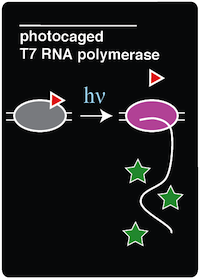Team:Austin Texas/photocage
From 2014.igem.org
(→Results) |
|||
| Line 128: | Line 128: | ||
[[Image:ONBY_GFP_Expression_After_Irradiation.jpg | 600px|thumb|left| Figure 3. GFP fluorescence observed after exposure to 365 nm light for the time indicated.'''reexport this figure''' ]] | [[Image:ONBY_GFP_Expression_After_Irradiation.jpg | 600px|thumb|left| Figure 3. GFP fluorescence observed after exposure to 365 nm light for the time indicated.'''reexport this figure''' ]] | ||
| - | To demonstrate the | + | To demonstrate the functionality of the light-activatable T7 RNAP, a GFP reporter was placed under the control of a T7 reporter. Cells with this plasmid were grown in culture with ONBY for 4-6 hours. These cells were then exposed to varying amounts of 365 nm light, ranging from 0 to 30 minutes. During this exposure, the ONB functional group at position ONBY639 should be released, resulting in de-caging of Y639. |
| - | After this exposure, the cells were grown for an additional | + | After this exposure, the cells were grown for an additional 16 hours, allowing the newly decaged T7 RNAP to transcribe the GFP reporter gene, which ultimately results in fluorescence. As can be seen in Figure 3, while the fluorescence background at time zero is not as low as we would like, there is a clear and dramatic increase in fluorescence that is directly dependent on the amount of time the culture was exposed to 365 nm light. This result is consistent with previous results using this system (Chou et al. 2010). |
=Discussion= | =Discussion= | ||
Revision as of 02:20, 17 October 2014
| |||||||||||||||||||||||||||||
 "
"




